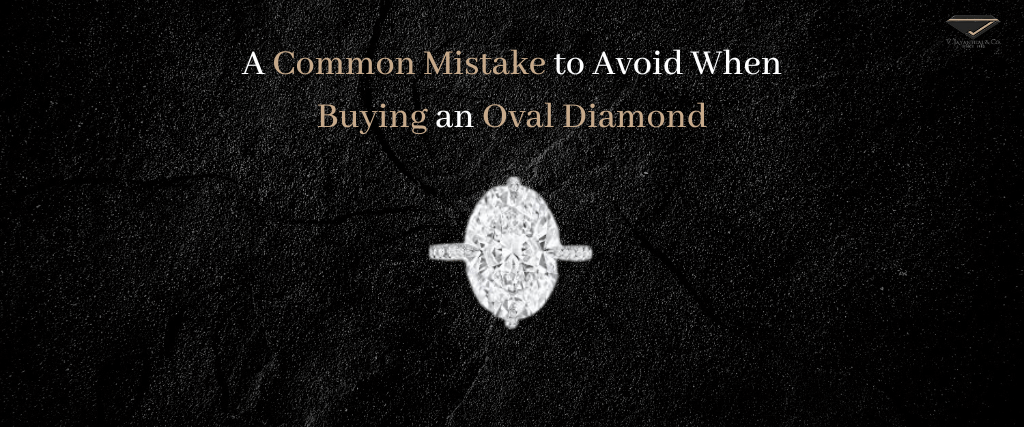
Choosing the perfect oval diamond is an exhilarating yet intricate process that involves navigating through a myriad of considerations to ensure you make a wise and satisfying purchase. The allure of the oval shape lies in its elegant and elongated form, often praised for its ability to create an illusion of length on the finger.
However, the journey to finding the ideal oval diamond is not without its challenges, as there are common pitfalls that prospective buyers may encounter.
In this blog, we will delve into the intricate details of the common oval diamond buying mistakes. From the essential considerations of the Four Cs – Cut, Color, Clarity, and Carat weight – to the often overlooked aspects like length-to-width ratio, bowtie effect, and symmetry, each facet contributes to the overall beauty and value of the diamond.
By understanding and sidestepping these potential pitfalls, you can empower yourself to make an informed and confident choice, ensuring that the oval diamond you select not only meets your expectations but also becomes a timeless symbol of elegance and enduring beauty.
Join us on this insightful journey to unravel the intricacies of oval diamond selection, and discover the keys to making a purchase that reflects your unique style, values, and budget constraints.
To help you make an informed decision, let's delve into the details of these oval diamond buying mistakes and how to avoid them.
Also Read- The Ultimate Oval Diamond Buying Guide: Expert Tips and Advice
A certified diamond provides a guarantee of quality and authenticity. Reputable gemological laboratories like GIA and AGS assess the characteristics of the diamond and provide a certification report.
To avoid oval diamond buying mistakes, always ask for and verify the diamond's certification to ensure that the diamond's description matches what you're purchasing.
The length-to-width ratio significantly influences the diamond's overall appearance. Oval diamonds come in various ratios, with a classic range typically falling between 1.30 to 1.50. However, personal preference plays a critical role.
Some prefer a more elongated oval, while others prefer a balanced shape. To avoid this oval diamond buying mistakes, choose the best oval diamond ratio that aligns with your aesthetic taste.
The bowtie effect is a shadow or dark area that may appear in the center of some oval diamonds due to their cut. To avoid disappointment, carefully inspect the diamond in various lighting conditions to assess the presence and intensity of the bowtie effect.
A well-cut oval diamond should have a minimal or imperceptible bowtie effect, as it can detract from the diamond's beauty.
Good symmetry is vital for oval diamonds, directly influencing their overall appearance. Check if the diamond's two halves are mirror images of each other and if the points at each end align correctly.
To avoid oval diamond buying mistakes, ensure that the diamond you choose displays excellent symmetry, as poor symmetry can result in an unattractive or unbalanced oval shape.
The choice of setting has a considerable impact on how the oval cut diamond looks when worn. Different settings complement oval diamonds differently. Halo settings, solitaires, and three-stone settings are popular choices.
Ensure that the chosen setting enhances the diamond's appearance, complements your style, and provides security. Neglecting this aspect can result in a less-than-ideal presentation of the diamond.
While the four Cs and other objective factors are crucial, personal preferences should not be ignored. Oval diamonds come in a variety of shapes, and individual tastes vary.
Take your time to explore various options and choose a diamond that resonates with your style and aesthetic preferences. What appeals to one person may not be the same for another.
Impulse buying is a common mistake to avoid. Rushing the purchase without adequate research and comparison can lead to regret later on. Take your time to explore different options, visit multiple jewelers or browse reputable online retailers, and gather information to make an informed decision.
A well-thought-out purchase is more likely to result in a diamond that meets your expectations.
Also Read - 9 Reasons to Buy Oval Shape Diamond
While sticking to your budget is essential, obsessing solely over the Oval diamond price factors can lead to sacrificing quality.
Consider the value you're getting for your budget. Prioritize the factors that matter most to you. It's worth investing in a quality oval diamond that aligns with your preferences and that you'll cherish for a lifetime.
Be cautious about buying oval diamond online. Purchase from reputable jewellers with a history of ethical practices and quality products.
Read reviews, ask for referrals, and ensure that the seller provides a clear return and exchange policy. Avoid buying from unknown or unverified sources, as it can lead to disappointment and potential issues down the road.
Purchasing an natural oval diamond involves careful consideration of multiple factors, including the four Cs, personal preferences, and budget constraints.
Avoiding common oval diamond buying mistakes, such as neglecting the four Cs, ignoring certification, and not considering the length-to-width ratio, is crucial to ensuring that your oval diamond is a stunning and valuable investment.
Take your time, do thorough research, and select a diamond that aligns with your style, values, and financial capacity.
At V. Jayantilal & co., we are passionate about providing high-quality oval diamonds in different carat sizes and the best customer service.
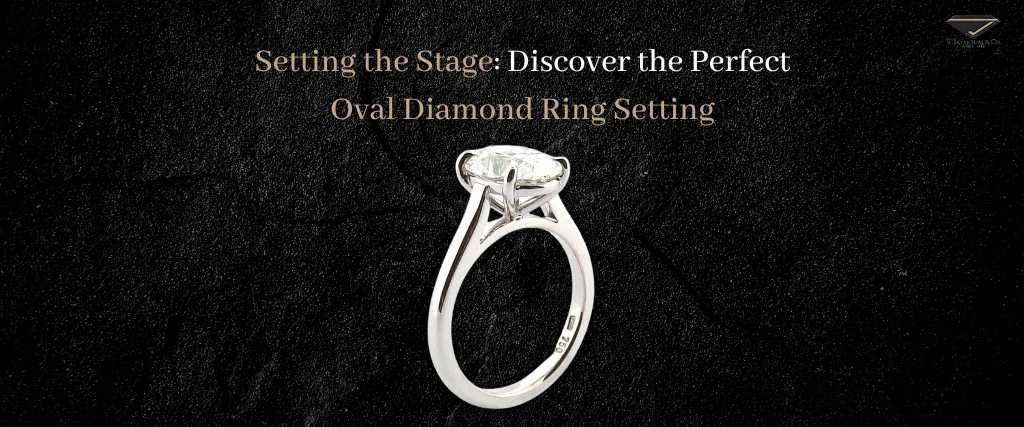
An oval diamond ring is the perfect choice if you want your engagement ring to look stunning. Oval Cut Diamonds are known for their uniqueness and timeless charm. Its elongated design makes it appear larger to the eye than other diamond cuts of the same carat weight.
Now that you’ve settled on the oval cut, you’ll want to be sure to select the perfect setting for it. There are a variety of oval diamond ring settings, so long as you tailor them to the shape and demands of the center stone.
As the name suggests, an oval-cut diamond is a symmetrical, elongated, and rounded shape. With their larger surface area. If you prefer a bigger diamond, an oval cut makes an impressive and economical option. Its slender shape can also make the finger appear longer and slimmer. An oval diamond cut has triangle, star, bezel, and kite-shaped facet patterns on the table anatomy with a 60-degree angle and soft curving edges. Also, the oval cut diamond’s middle girdle facets are swallowed from the left to the right side, but the north-to-south surfaces are narrower. This makes oval-shaped engagement rings an ideal selection for all ring styles.
The oval diamond is egg-shaped because its faceting patterns aren’t matched in other shapes of structures like squares or rectangles. An oval-shaped diamond has 57 facets on the crown, girdle, and pavilion anatomy.
There are three reasons to choose an oval-cut diamond for an engagement ring: the attractive faceting patterns, more length, and being the best alternative to round-cut diamonds. The factors mentioned above play a vital role in oval-cut diamond engagement rings.
Let’s understand them in depth.
An oval diamond has four numbers of shapes facets triangles, bezels, stars, and kites. These shaped facets help the diamond anatomy receive and issue the most precious lightning resonations in a proper way. The brilliance reflection in an oval diamond cut depends on the faceting patterns. That’s all.
The fancy-shaped faceting patterns make the oval-shaped rings preferable for engagements. In all engagement ring settings, the oval diamond shape sustains and preserves the brilliant reflections; that are eye-catching for anyone.
Oval and emerald diamond cuts have the same length because they have been used as an alternative option. The reason for the oval diamond's length is that it has soft banding edges that comply with the girdle and crown anatomy.
The length of the oval-cut diamond is acceptable for solitaire to halo settings in all gold variations.
While talking about an emerald-cut diamond’s length, a parallel facet is responsible for that. Due to the parallel faceting patterns, it needs more space to determine the flow of light reflections.
The fact is that 90°-angled faceting styles are found in the emerald diamond cut. Therefore, the emerald diamond cut has more length.
The oval diamond cut is an alternative to the round diamond cut because they have the same facets in their anatomy. But an oval-shaped diamond has one more benefit than a round cut. The oval diamond has a length that covers the size of the finger in the engagement ring.
For this reason, an oval diamond is used as an alternative to a round diamond. The price for a round cut and an oval diamond shape isn't the same. The oval diamond shape is cheaper than the round-cut diamond.
Moreover, the oval diamond is suitable for all kinds of ring styles.
A halo setting is a popular choice for oval-cut rings. A halo setting is the best way to enhance your ring if a larger center stone is out of your price range because it magnifies the fire and brilliance of an oval cut's natural brilliance. The halo setting for oval diamond ring is the perfect choice for those who are looking for maximum sparkle.
A three-stone oval engagement ring represents the factors of romance, dedication, and commitment in a love relationship. An oval-cut diamond with a three-stone ring design makes a proposal moment memorable because of its reflective appearance on the hands.
If you want customized antique cut diamonds as accent stones, they're available in a baguette, hexagon, bullet, trillion, emerald, round, or Asscher cut. Then decide on a metal tone based on your preferences and price range.
The solitaire is perhaps the most popular oval diamond ring setting because it so beautifully allows the unique shape and brilliance of the center stone to stand out.
Even if you can’t afford a celebrity-sized stone, a solitaire oval diamond ring setting can be an elegant way to showcase your diamond. You could vary the color of the band to add a glamorous, chic twist to your look. Rose gold works particularly well with oval-cut diamonds. To make your ring stand out while keeping it elegant in a solitaire setting, think about adding a pop of color.
It’s less common to see an oval diamond ring setting with prominent side stones, but if you choose complementary cuts, it can be a rare thing of beauty.
A half-moon diamond is a good compromise if you prefer a rounded appearance. Avoid a setting with large round stones on the side because their shape clashes with the elongated symmetry of the oval shape.
Choosing an antique oval diamond ring setting may seem counter-intuitive given that the oval cut wasn't invented until the 1960s. But there are many lovely vintage-inspired settings that will go fantastically with an oval diamond.
Since so few people choose this setting option for an oval diamond, if you select an antique setting, your ring is more likely to be truly unique. It’s the perfect way to blend the timeless elegance of the past with modernity and show the world that you alone define your style.
One of the best settings for oval diamonds ring is the prong. The majority of the stone can be seen due to the traditional mounting type, which lets more light penetrate the diamond and raises its brightness.
Most prong settings feature four or six prongs. Four prongs allow you to see more of the stone, while six prongs make the diamond more secure but can make the diamond appear smaller.
One downside of the prong setting is that it leaves a portion of the diamond surface more susceptible to accidental damage.
A bezel oval diamond ring setting is also a popular choice among women. It encircles the diamond with a thin metal frame that holds the stone in place, which can protect the diamond from accidental damage.
A bezel setting can be full or half; a full bezel surrounds the diamond, while a half bezel leaves it open on the sides. Depending on its structure, the bezel setting can also give the diamond a more subtle look, which can reduce the stone’s brilliance due to less light being able to enter the stone.
An engagement ring with an oval diamond is quite the best selection for making loving moments mesmerizing. Buyers can reveal their love feelings with oval engagement rings, but they have some essential points to consider when buying.
At V. Jayantilal & Co., we’re here to offer you 100% high-quality diamonds at an affordable price range.
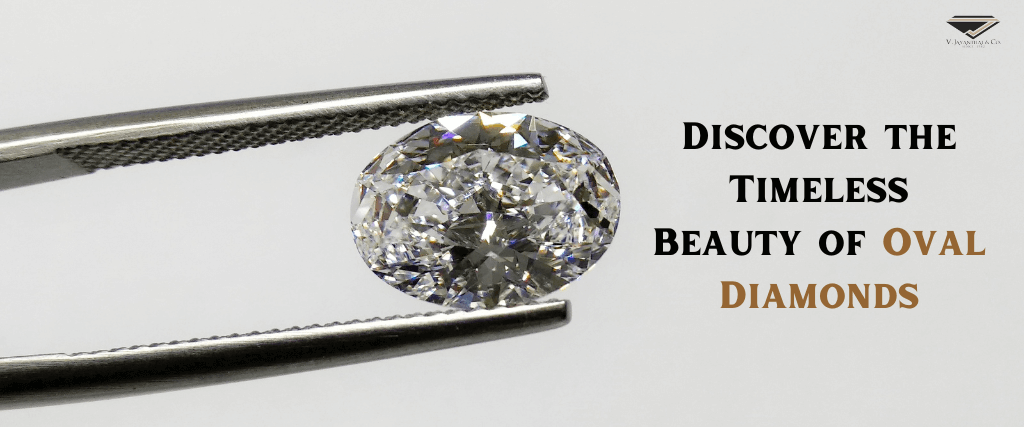
One of those timeless cuts, The Oval diamond, needs little introduction. Similar to the Round diamond, it is capable of speaking for itself and persuading many customers that it is the best option for them. Contrary to the round, it's a fantastic form to take into account if you want to deviate from "the norm" without going too far in the other direction. An oval diamond features an extended round form with a unique twist on understated beauty. Its fire may equal that of a round brilliant when it is faceted in a brilliant manner. The most typical facet configuration for an oval diamond is eight bezel facets on the crown and eight primary facets on the pavilion.
Oval diamonds are popular with many individuals for the following persuasive reasons: Oval diamonds might look bigger to the eye than round diamonds of the same carat weight because they have a larger surface area. The finger may appear longer due to the oval shape. In addition, because an oval diamond lacks sharp angles or corners, it is less likely to chip than other exquisite shapes. Obviously, there’s a lot more to know about the Oval cut than that, but extolling the virtues of this classic cut is certainly a great place to start.
One of the earliest types of diamonds is the oval. Lazare Kaplan, a Russian diamond cutter, improved the form in the 1960s. For the most dazzling, full-of-fire oval-cut diamond, he invented the cutting technique still in use today. Before designing the Modern Oval Cut, Kaplan gained a reputation for his extraordinary talents in cleaving, a procedure in which fractured or terribly defective diamonds are cut into smaller, minimally included gems. Inarguably one of the best-known diamonds in the world, the Koh-I-Noor, or ‘mountain of light, has featured an Oval cut since the mid-nineteenth century. Weighing 105.602 carats, the diamond is now in the possession of Queen Elizabeth II and resides in the Tower of London. Thousands of people have flocked to see it and the incredible glitter that the Oval cut offers throughout the years.
There are several options for settings for engagement rings with oval diamonds. And any option can provide a noticeably distinct appearance. Here are some options.
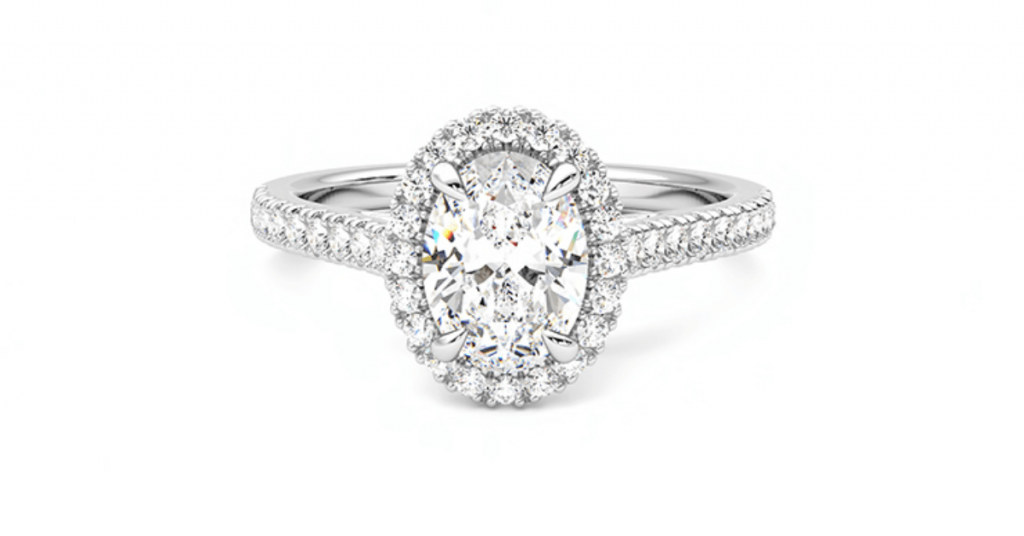
The circular centre stone is surrounded by a stunning halo of lesser diamonds. It draws attention to the form and gives the diamond a bigger appearance. A striking appearance may be achieved by selecting a unique metal colour or side stone.
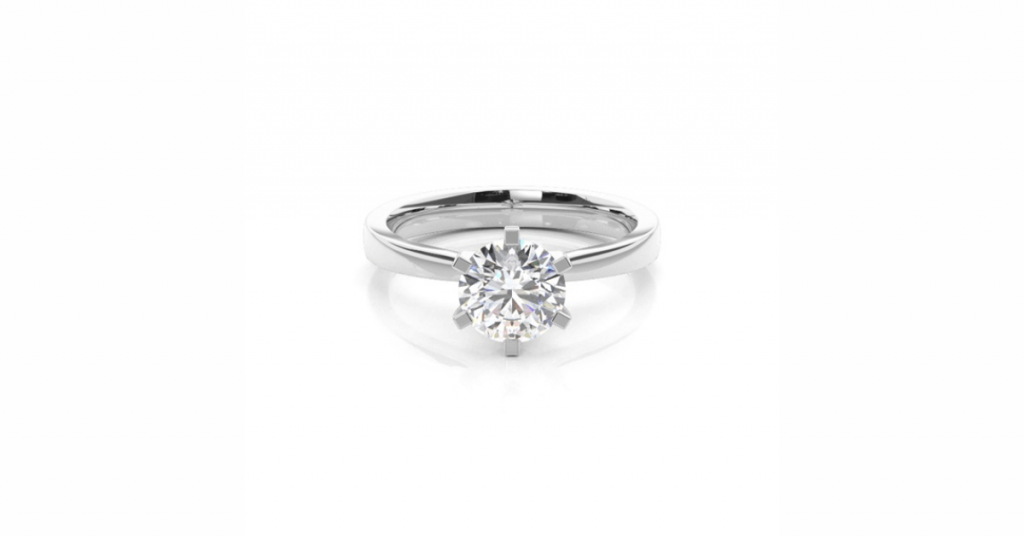
A decent setting for an oval diamond is a prong setting. They not only shield the diamond from damage, but they may also provide height, lifting the stone above the band and catching the viewer's attention.

If you lead an active lifestyle, a bezel setting, which entirely encloses the diamond's edge in metal, is an excellent option. It’s an effective way to protect the diamond and also enhances the beauty of the oval shape.
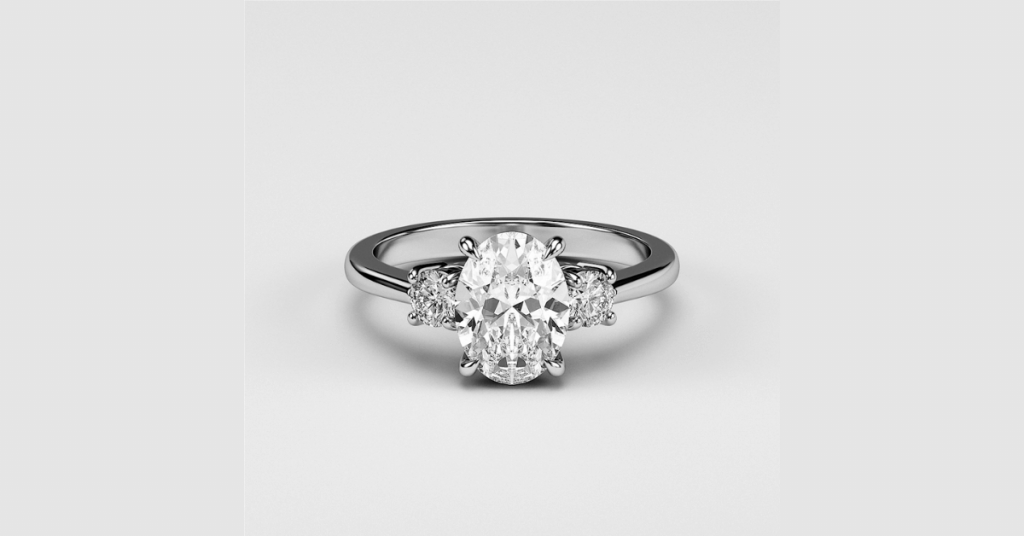
Almost any side stone looks good with an oval diamond. Its form is echoed by half-moon diamonds, which makes them a desirable option. Baguettes and tapering baguettes, as well as coloured gems, provide a chance to establish contrast. Choose side stones that are within one or two colour grades of the main diamond to avoid competing with its beauty if you want your diamond side stones to complement the centre oval.
The most accurate determinant of a diamond's brilliance, brightness, and overall beauty is its cut, which is the most crucial C of all.
The GIA does not assign oval diamonds the same overall cut grade as it does round brilliants, like all fancy cut diamonds. But all is not lost, since there are many more statistics that may be used to describe a diamond's cut. See our table below for a starting point for cut quality.
Remember that although though statistics are an excellent place to start to weed out low-quality diamonds, your best chance is always to see a diamond in person or on video and work with a reputable jeweller to locate the finest quality diamond in your price range. Oval diamonds are particularly arbitrary, and beauty is genuinely in the eye of the beholder (rather than the numbers).
Oval cut diamonds show color more than other diamond shapes, so you'll want to opt for a higher color grade to get a certain look - whether that be cool and colorless or sunny champagne. The larger the diamond, the more obvious the color differences will be.
However, the distinctions between two (or even three) colour classes are frequently indiscernible to the unaided eye, so put your attention on choosing the diamond colour that you adore visually rather than spending more money for a barely noticeable letter grade.
Carat refers to a diamond's weight and not its size as many people believe. Thanks to their elongated shape, oval cut diamonds tend to look bigger for their carat weight vs other diamond shapes like a round cut diamond.
While sizes vary depending on how a stone is cut, a one-carat round diamond usually measures 6.5 x 6.5 mm, whereas an average oval cut diamond is usually 7.7 x 5.7mm - the extra height provides the impression that it is bigger. Therefore, think about an oval cut if you want a diamond that appears larger than its actual carat weight.
The quantity of imperfections or flaws in a diamond is referred to as clarity. The oval shape and superb cutting help oval-cut diamonds to effectively conceal flaws. This implies that you may choose a diamond with a lesser clarity grade and yet have it be eye-clean. Now you're free to spend your budget on more important factors, like cuts.
Remember that imperfections closer to the margins of the stone will be easier to conceal than those closer to the centre.
Flawless (FL): No inclusions or blemishes can be seen with 10x magnification.
Internally Flawless (IF) - With a 10x magnification, several imperfections (but no inclusions) are visible.
Very, Very Slightly Included (VVS1 and VVS2) - Under a 10x magnification, inclusions are difficult to notice.
Very Slightly Included (VS1 and VS2) - Minor inclusions can be seen under 10x magnification
Slightly Included (SI1 and SI2) - inclusions that are visible at a 10x magnification
Included (I1, I2, and I3) - Obvious inclusions under 10× magnification
When looking for an oval diamond, consult the 4Cs of diamond quality. Oval diamonds are judged for their carat weight, colour, and clarity using the same standards as round brilliants. This might help you narrow down your search.
When viewing oval diamonds, keep proportion in mind. According to a thorough study of form preferences done by GIA in 2009, consumers and industry experts tend to favour a longer oval shape. According to the poll, ovals with a length to width ratio of 1.7:1 were the most common shape. You won't often find one since it is impractical to cut such lengthy oval diamonds from the raw rough. Ovals with ratios between 1.3:1 and 1.4:1 are more common.
In order to create the beauty of an oval diamond, symmetry is crucial. Draw a line along the centre of an oval diamond to see if it is symmetrical. The two sides' faceting and form should be identical. Next, trace a hypothetical line across the oval's centre. Again, the two parts should have the same faceting and form.
Look for an oval diamond with a lovely contour and sections that are evenly spaced apart. It is beneficial to contrast many various oval diamonds in order to pick one that appeals to you.
The pavilion and crown come together at the girdle. It serves as the diamond's setting edge and defines the diamond's perimeter. Rounds and fancy shapes both use the same criteria to determine girdle thickness. Make sure to review the percentage diagram in the diamond's GIA Diamond Grading Report. Indicating whether the girdle is excessively thick or thin, the figure will display the stone's average girdle thickness percentage. Overly thick girdles can make a diamond heavier than its face-up appearance suggests, while tiny girdles can make damage like chipping more likely.
A seemingly dull or darker core that resembles a black bow tie is known as the "bow tie effect." It is a location where light leaks rather than being reflected. The bow tie effect reduces diamond brilliance, although it only shows up when the oval cut is too shallow or deep. The presence of a bow tie will drive down the price of a loose diamond. A bow tie is caused by an issue with the diamond’s facets, which causes an area of reduced light within the centre of the diamond. The facets of a diamond work like a series of mirrors to reflect light back into your eye from everywhere around you. The dark contrast you observe as you gaze at the stone is a reflection of your head and shoulders, which are obstructing light from reaching the diamond. The bow tie will be more obvious the closer your face is to the diamond. If the diamond is cut correctly, the bow tie will be small, but once you are in front of the diamond, there will always be some measure of a bow tie.
Overall, oval-cut diamond rings have a bigger, longer appearance than round brilliant diamond rings but nevertheless have a similar level of brightness and scintillation. They go well with rings that have bigger accent stones since they are beautiful and feminine. Oval diamond forms of the highest caliber are offered at competitive prices by V. Jayantilal & Co.
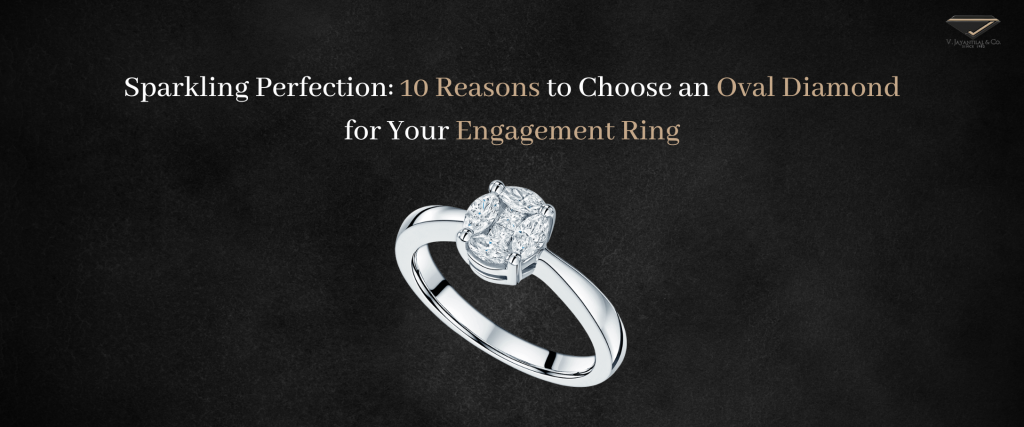
Every couple of years, a new engagement ring form gains popularity, which causes costs to increase owing to great demand. For a number of years, the title has belonged to the oval-shaped diamond engagement ring. In the realm of fine jewellery, the oval ring serves as a steady friend. oval diamond is the second most popular diamond cut after round diamond, it has a mark on day one and continues to be loved by fashion magazines and engagement ring trendsetters. The most extraordinary aspect of this traditional diamond cut is that it flatters every finger type and carat.
So, diamond oval rings are for you if you desire a large, magnificent diamond ring with exceptional brilliance and wonderful glitter! Here is the benefit of buying oval diamond engagement ring:
Oval diamonds are very similar to round diamonds in terms of brilliance and sparkle. However, an oval has a naturally elongated shape that appears more prominently on the finger. Despite having identical carat weights, the oval diamond will take up more space on the ring finger due to its elongated shape. Oval diamonds may be the most costly form on the market right now, but they're a safe and wise approach to buying oval diamond, considering you’ll receive the most for your money.
One thing to keep in mind with an oval diamond is that the color and clarity will stand out more the larger the center stone. Jewellers recommend staying between D and F on the color scale if the oval is 1.00 ct. and up. If you're searching for an eye-clean oval diamond of 1.5 ct and higher, it is advised to stick with VS1-VS2 clarity.
The apparent bow-tie configuration within an oval-cut diamond distinguishes it from other diamond forms. The oval diamond's cut prevents light from bouncing back and forth in the centre, which results in the bow tie effect. The bow tie is one of the numerous characteristics of an oval diamond that make it attractive and unique. However, in order to maintain the oval diamond's uniqueness, you must be attentive while selecting the setting. Even though an oval-cut diamond combines well with most settings, the inappropriate setting can wind up overpowering and outshining the centre stone. An oval diamond looks lovely in a halo setting, a prong setting, or a bezel setting.
Oval-cut diamonds are more unique than round-cut ones and are surprisingly cheaper. The cost climbs by a few thousand dollars every time you raise the carat size. An oval diamond cut gives the illusion of a larger cut stone—without the added cost. If you want to buy engagement ring for woman use the extra money to plan your ideal honeymoon. In actuality, the diamond's elongated oval form deceives the eye into perceiving more. Therefore, an oval diamond ring appears much bigger than a round diamond that weighs the same.
Everyone aspires to have long, graceful fingers, but some of us are just not so blessed. The oval shape of the diamond might give the appearance of longer, slimmer fingers on women if you're trying to trim down. When you are wearing an oval-cut diamond, this is not a problem. The curve of the ring organically elongates your fingers, giving you that desired gracefulness. Before making a decision, always try various stone shapes to make sure the ring's form suits your finger.
An oval-shaped diamond is versatile in that it pairs well with most settings. choosing the right setting is almost as crucial as picking the center stone. The improper setting may overwhelm and outshine the central stone. Here are some examples of previous oval diamond settings that past clients of Diamond Mansion have opted for. Some popular settings for oval diamonds include the solitaire, halo, and three-stone settings. The solitaire setting is a classic and timeless choice, while the halo setting adds extra sparkle and emphasizes the oval shape.
It might be difficult to choose the ideal diamond because they come in a variety of cuts, styles, and sizes. The stunning traditional cuts of round and princess diamonds are very well-liked. In fact, they are a touch too famous, causing them to lose their distinctiveness. An oval-cut diamond, on the other hand, is a spectacularly unique stone that will undoubtedly draw people's attention. For those seeking some diversity, the standard oval diamond shape is a timeless classic and elegant option.
When it comes to oval engagement ring designs, you can employ a concealed halo, a three-stone setting, or encircle your oval stone with hundreds of accent diamonds. If you want to make your love gift more unique, choose an oval diamond cut ring. If your perfect engagement ring only exists in your mind, contact us today so we can make it a reality.
Celebrities are known for living lavish lifestyles. Proposals and engagement rings are no exception. Oval diamonds gained appeal, according to some, when Blake Lively's longtime husband, Ryan Reynolds, proposed to her with a 12-carat pink oval diamond engagement ring. The ring, which Lorraine Schwartz created, is valued at $2 million.
Any diamond with sharp corners is likely to catch on surfaces while you are performing routine tasks, increasing the risk of breaking the prongs that hold the stone in place. A square-cut diamond's prongs are far more likely to break than those of an oval diamond. Oval diamonds are great practical wear for every day because they have no sharp corners.
The oval engagement ring is more exotic than its round cut, but it still has many of the same advantages as a round stone, including durability. Because there are no sharp edges, an oval cut is difficult to chip, and it's almost impossible when you choose a durable stone, like a diamond.
The most popular diamond form on the market right now is the oval, with round and cushion diamonds coming in second and third, respectively. Everyone has different styles and tastes, especially when it comes to engagement rings and other jewellery. There is no right or wrong answer to which shape to choose. If you can’t decide on just one, ask your jeweller how you can incorporate other shapes of diamonds into your design. However, a diamond oval engagement ring unquestionably gives your partner's hand classic shine.
At V. Jayantilal & Co., we design and customizes the engagement ring of your dreams from scratch. Regardless of the cut, size, and shape, we can help you find an engagement ring that is just right for you! Head over to our website to speak with our experienced ring specialists.